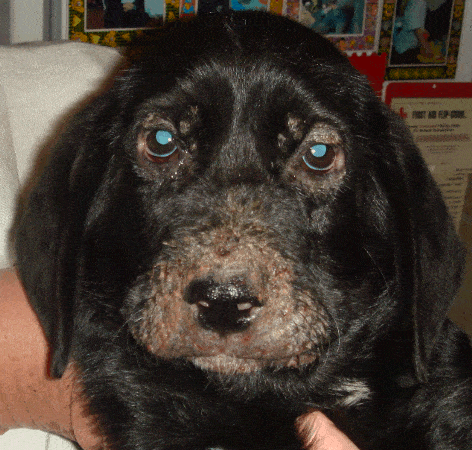-
Adopt
-
Veterinary Care
Services
Client Information
- What to Expect – Angell Boston
- Client Rights and Responsibilities
- Payments / Financial Assistance
- Pharmacy
- Client Policies
- Our Doctors
- Grief Support / Counseling
- Directions and Parking
- Helpful “How-to” Pet Care
Online Payments
Emergency: Boston
Emergency: Waltham
Poison Control Hotline
-
Programs & Resources
- Careers
-
Donate Now
![]()
 x
x
Jordana Fetto, DVM
angell.org/west-ecc
emergency@angell.org
781-902-8400
April 2025
x
xx
Veterinarians often encounter concerned pet owners who bring their puppies in with alarming symptoms such as severe facial swelling, fever, and pustules. One condition that can cause these symptoms is called “puppy strangles,” or juvenile cellulitis. While this condition can be alarming for both owners and puppies, it’s important to know that with prompt veterinary care, puppies can recover fully. Here’s a brief overview of puppy strangles, how they affect your puppy, and what can be done to help.
both owners and puppies, it’s important to know that with prompt veterinary care, puppies can recover fully. Here’s a brief overview of puppy strangles, how they affect your puppy, and what can be done to help.
What Is Puppy Strangles?
Puppy strangles, medically known as juvenile cellulitis or sterile granulomatous dermatitis and lymphadenitis, is a rare and unusual immune system disorder that typically affects puppies between 3 weeks and 6 months. The condition is characterized by inflammation of the skin, often seen around the face, neck, and ears. It causes the puppy’s lymph nodes under the jaw to become swollen and may develop pustules (pus-filled bumps) on the skin. In severe cases, the skin can ulcerate, forming crusts, and the puppy may experience fever and/or loss of appetite.
What Causes Puppy Strangles?
While the exact cause of puppy strangles is still not fully understood, it is believed to be an autoimmune disorder. This means the puppy’s immune system mistakenly targets its own body, causing inflammation in the skin and surrounding areas. Some researchers suggest that an environmental trigger, such as bacteria or viruses, could potentially initiate the immune response, but genetics may also play a role.
Signs to Watch For
The signs of puppy strangles can vary, but they generally start with:
- Swelling around the eyes, face, and neck
- Pustules or abscesses (pus-filled bumps) on the skin
- Crusty or ulcerated lesions, particularly around the ears
- Swollen lymph nodes under the chin or neck
- Fever, lethargy, and a decrease in appetite
If you notice these symptoms in your puppy, it is important to contact your veterinarian immediately for a proper diagnosis and treatment plan.
Diagnosis and Treatment
Diagnosing puppy strangles is primarily based on clinical signs and the exclusion of other potential causes for the symptoms. A veterinarian may perform skin scrapings or biopsies, although these are not always necessary if the clinical presentation is clear. Blood tests may also be used to evaluate overall health and rule out infections or other conditions.
Fortunately, puppy strangles can be treated effectively with medication. Corticosteroids, such as prednisone, are commonly prescribed to reduce inflammation and control the immune response. In some cases, antibiotics may be recommended if there is a secondary bacterial infection. With early diagnosis and appropriate treatment, most puppies recover fully, and the condition does not cause long-term issues.
Caring for Your Puppy During Recovery
While your puppy is undergoing treatment, there are a few things you can do to make them more comfortable:
- Keep the affected areas clean and dry to prevent secondary infections
- Provide a quiet and calm environment to help reduce stress
- Ensure your puppy is eating and drinking adequately, as their appetite may be affected
- Follow up with your veterinarian to monitor the progress of recovery and adjust medications if necessary
Is Puppy Strangles Preventable?
Unfortunately, puppy strangles is not a condition that can be easily prevented, as it is likely tied to genetic or immune system factors. However, early detection and treatment are key to a successful recovery. It is important to maintain regular vet visits for vaccinations, parasite control, and general health checks to ensure your puppy’s well-being during their formative months.
Final Thoughts
Although puppy strangles is a concerning condition, it is treatable, and most puppies make a full recovery with the right veterinary care. As always, if you have any concerns about your puppy’s health or notice any signs of illness, don’t hesitate to contact your veterinarian for guidance. Early intervention is the best way to ensure your puppy grows up happy, healthy, and thriving.
References
- Noli, C., & Caprilli, F. (2015). Juvenile cellulitis in dogs: A review. Veterinary Dermatology, 26(1), 56-63.
- Bjerkås, I., & Kvam, T. (2001). Juvenile cellulitis (puppy strangles): A review of 37 cases in dogs. Veterinary Dermatology, 12(3), 133-137.
- Marlow, S. (2016). Immune-mediated diseases in puppies: A clinical overview. Veterinary Practice, 8(3), 45-51.